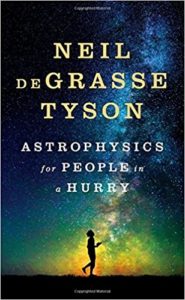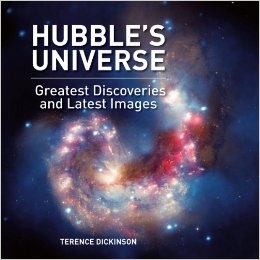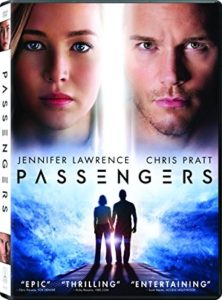
“Space is big. You just won’t believe how vastly, hugely, mind-bogglingly big it is. I mean, you may think it’s a long way down the road to the chemist’s, but that’s just peanuts to space,” – Douglas Adams,The Hitchhiker’s Guide to the Galaxy.
Ever since the 1950s, us humans haven’t been able to stop sending bits of metal with a living accompaniment (or robots) up into the sky to just find out what is up with all that space. And even before that, we made telescopes as large as humanly possible just so we could look at all that space. The average person doesn’t have to go to astronaut school to find what’s been discovered and explored so far. Just go to your local library.
In a slim volume called “Astrophysics for People in a Hurry,” Neil deGrasse Tyson covers the Big Bang, the cosmos, dark matter, and more. While it’s an overwhelming amount of information in one little book, Tyson’s strengths are making the complicated sound simple and understandable, especially for the average Joe.
are making the complicated sound simple and understandable, especially for the average Joe.
To take a look at the history of humans discovering just how high up they can go, first using helium and hydrogen and then rockets, read The History of Human Space Flight by Ted Spitzmille. He writes about the Space Race, the successes and failures (or successful failures like Apollo 13), and more.
But to learn about the stars and space itself, Universal Class offers an “Astronomy 101” online course that will help you turn into an amateur astronomer. It covers black holes, quasars, supernovas, brown dwarfs, the string theory, space travel, the solar system, the galaxy, and what lies even further than that. This course is offered for free online with a Heartland Cooperative Library card.
 If you just want to look at space, there are some great pictures you can “ooh” and “aah” at in bestselling author Terence Dickinson’s Hubble’s Universe : Greatest Discoveries and Latest Images. It has over 300 high-resolution photos of the celestials from the Hubble Space Telescope for your happy viewing.
If you just want to look at space, there are some great pictures you can “ooh” and “aah” at in bestselling author Terence Dickinson’s Hubble’s Universe : Greatest Discoveries and Latest Images. It has over 300 high-resolution photos of the celestials from the Hubble Space Telescope for your happy viewing.
How can one doubt our interest in the stars? The fascination and awe exists because we keep making science fiction books and movies that explore our preoccupation with the space above. And it can be almost any kind of story, whether it’s a historical look backwards about black female mathematicians who got America to the moon in Hidden Figures, a teen romance flick about a boy born on Mars like The Space Between Us, an astronaut stranded on Mars in The Martian, or even a thriller drama on a spaceship headed for new life like Passengers. (And that’s not even touching on all the Star Trek or Star Wars stories out there) Science fiction constantly ponders, questions, and reflects on our relationship with space.
headed for new life like Passengers. (And that’s not even touching on all the Star Trek or Star Wars stories out there) Science fiction constantly ponders, questions, and reflects on our relationship with space.
For all of these titles and more, head to your local library to check out or request a copy, or set up a library card so you can take an online course and learn more.